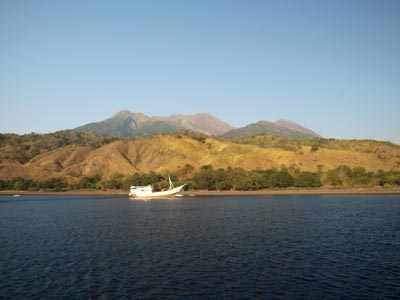|
Michael McFadyen's Scuba Diving - Bonto Reef, Indonesia
In September 2012 Kelly and I did a week long liveaboard dive trip in Indonesia which went from Bali to Komodo and back. We went on the MV Mermaid II. Click here to read about the boat. This is one of the dive sites we did on the trip. The trip heads north-east from Benoa Harbour on Bali out north of Lombok and then north of the other islands to Komodo Island and then down the eastern side of Komodo to the southernmost point of Komodo. For all dives on this trip we used 31% Nitrox, so bear this in mind when considering the bottom times we did.
Sangeang Island (Pulau Sangeang) is located off the north-eastern corner of Sumbawa Island. It is home to an active volcano called Sangeang Api. The volcano is the almost perfect conical shape, and as such, the island is circular. It is almost uninhabited, about 15 kilometres in diameter and 1,949 metres high. It last erupted in 1989. This site is off the western side of the island. An approximate GPS mark for the dive spot is 8° 12' 36.1"S 118° 59' 58.1"E (using WGS84 as the datum). The site is towards the shore from the GPS mark.
 |  |
| A satellite photo from Google Earth that shows the location of the dive site | A photo of the dive site |
The actual site is located in a small bay off a village and beach. When we were here there was a large fishing boat (under repair) moored off the beach. The site is black sand which slopes from five metres down to 20 metres.
As with virtually all dive sites that you do when on MV Mermaid II, you use the RIB (rigid inflatable boat) to get to the start of the dive (and also to get back to the boat). The RIB will drop you normally about 50 metres off the beach towards the north of the bay.
Once in the water, we dropped to 16 metres on a black sand bottom. We headed to the south at this depth for about 30 minutes. Like other places in this area, although it is a sandy bottom, there is an amazing amount of marine life to be found. We swim very slowly, spread out to enable us to spot more critters.
Within a short time (a few minutes) we start to see incredible amounts of macro life. There are decorator crabs running around, each one with a number of small anemones on its adopted shell. Tiny bob-tailed cuttlefish, a bit like striped dumpling squid we get in Sydney, swim around and then hide in the sand. They are about 10 mm long, hard to spot once they decide to disappear.
There are small soft corals, most with dozens of skeleton shrimp on some of them. Skeleton shrimp are amazing, they are so tiny and skinny, but every one of them appears to be fighting the closest skeleton shrimp.
We seem to move very slow, no more than a minute or two goes by without one of our group finding more interesting things. There are worms of many sorts, what appear to be some sort of pygmy pipehorse. This is what they appeared to be to me as they attach themselves to objects by their tails.
After 30 minutes we reach a sand ridge and turn left to the east and ascend to about five metres. Once here, we head north. This brings us back under the fishing boat. When we near this we see lots of junk on the bottom. They are repairing the boat and have dumped the old timbers and paint off the hull into the water, as well as the off cuts of the new timbers.
All this junk is not a real environmentally bad thing, as it creates protection to lots of species. We see large numbers of nudibranchs, sea spiders, firefish (lionfish), red shrimp and more. We see some ornate ghost pipefish and under the stern of the boat, a beautiful clown anglerfish. The anglerfish is tiny, about 20 mm long and white, red and yellow.
This was a brilliant night dive, once again one of the best I have ever done (and I have down close to 400). The visibility was probably 30 metres and the water temperature was about 27°C.
Click here to return to the list of sites we did on our MV Mermaid II trip.
| 
 v6.00.307 © 2003-2005
v6.00.307 © 2003-2005